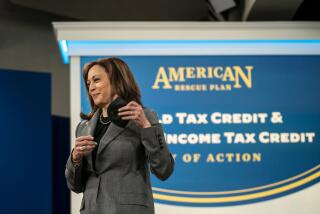Tax Reform Is Back On Track : Two-Bracket System Would Rebuild a Land of Opportunity
At the stroke of 12 with tax reform foundering, Sen. Bob Packwood and the Senate Finance Committee, in a surprise move, cut through traditional resistance and reported out a bill that would cut tax rates to 27%. For the first time in more than half a century, Americans have the prospect of being taxed at lower rates than medieval serfs, who owed the feudal state one-third of their working time.
The Finance Committee’s unanimous reaffirmation of the rights of individuals to almost three-fourths of the products of their own labor is a big change from a few years ago when the government’s claim to an individual’s income could approach 70%. The proposed two-bracket system with rates of 15% and 27% is an important step toward rebuilding America as a land of opportunity.
It is also a victory for supply-side economics. It used to be that tax reform meant closing loopholes while keeping tax rates high. Historically, tax reform was a demagogic cause directed at “making the rich pay.” But in the early hours of May 7, excitement over the prospect of reducing the penalties placed on success unified a badly split and stalemated group of senators, and they took an action that elevated the general interest by limiting the claims of the central government. All hopeful people should welcome this prospect that the American democracy has gained sufficient maturity to set aside envy and focus on opportunity as the galvanizing force in politics.
The Finance Committee bill is being proclaimed as a victory over special interests, but that is misleading. The bill is really a victory over erroneous economic and social ideas that had justified high tax rates for most of this century. So-called tax loopholes have their origin in the pragmatic response of legislators to the economically destructive effects of high tax rates. Cutting the rates removes the need for the loopholes.
In the end everyone gains, but in the meantime there will be gainers and losers as people adjust to the new rules. For example, the tax-reform bill treats the active losses of legitimate real-estate investors the same as the passive losses of real-estate shelters. It is difficult to have perfect transitional rules that “keep people whole” while society moves to a new track, but the fairer they are, the less bloody the revolution will be.
The revolution, however, is far from complete. The Finance Committee’s bill is partly a result of frustration with the old system and only partly a result of understanding how to collect enough revenue at the least cost to the economy. The bill leaves the code encumbered with many elements of the old system. It will be important to keep that in mind as the bill goes to the Senate floor and then to conference with the House. If the light that guided the Finance Committee is snuffed out along the way, tax reform will be more rhetoric than reality.
For all the virtues of lower tax rates, the bill does take some steps backward. For example, it raises the tax rate on capital gains from 20% to 27%, even though the committee does not expect more revenue from the higher tax rate. This economically harmful action was taken solely in order to appease liberals who were afraid that a few rich people might get away with paying less than 27%.
The underlying resentment of the wealthy dies hard. It rears its ugly head in two other provisions of the bill that discriminate against upper-income taxpayers and force them to pay a higher rate than the statutory maximum. One provision phases out the 15% rate that applies to lower-bracket income; another provision phases out the personal exemption. Consequently, a married couple filing a joint return with taxable income between $75,000 and $185,000 is taxed at a marginal rate of 32%. If there are a large number of dependents, the rate can be even higher. In addition to being discriminatory, it is deceptive to have a tax system with a 27% maximum rate that effectively taxes people at 32% and higher.
A similar element of deception characterizes the bill’s approach to business taxation. Depreciation schedules are specified in the bill, but if companies actually use them they are subject to a minimum tax that works against the intended effect of the depreciation allowances. The result is a complicated tax code for no real purpose.
High tax rates and complexity are not the only faults of the current tax code. Prime among its faults is the tax bias against saving that results from the multiple taxation of income that is saved and invested. Individual Retirement Accounts and 401(k) pension plans help to reduce this bias. The Finance Committee bill, which repeals the IRA deduction for people with pension plans and curtails other private pension plans, is a step away from the neutral treatment of saving.
Nevertheless, a 27% top statutory rate makes up for a lot. It proclaims to the world that Americans have stopped feeling guilty and being hypocritical about their capitalist society and that they now accept the contribution of individual incentives to social progress.
More to Read
Get the L.A. Times Politics newsletter
Deeply reported insights into legislation, politics and policy from Sacramento, Washington and beyond. In your inbox three times per week.
You may occasionally receive promotional content from the Los Angeles Times.










